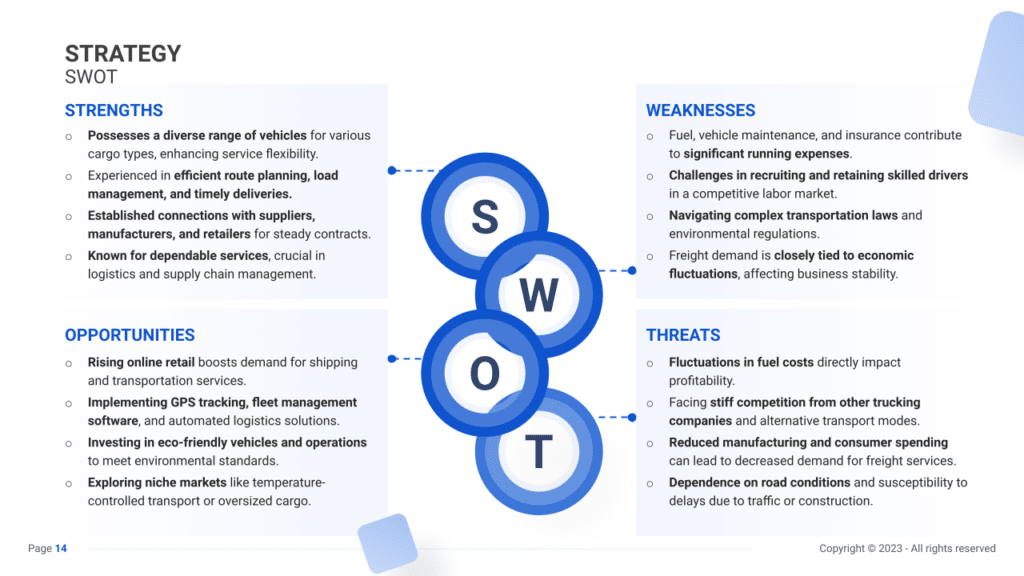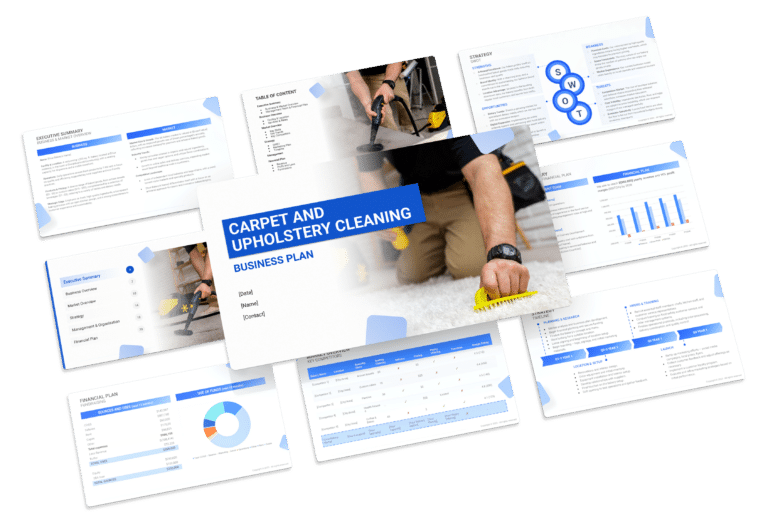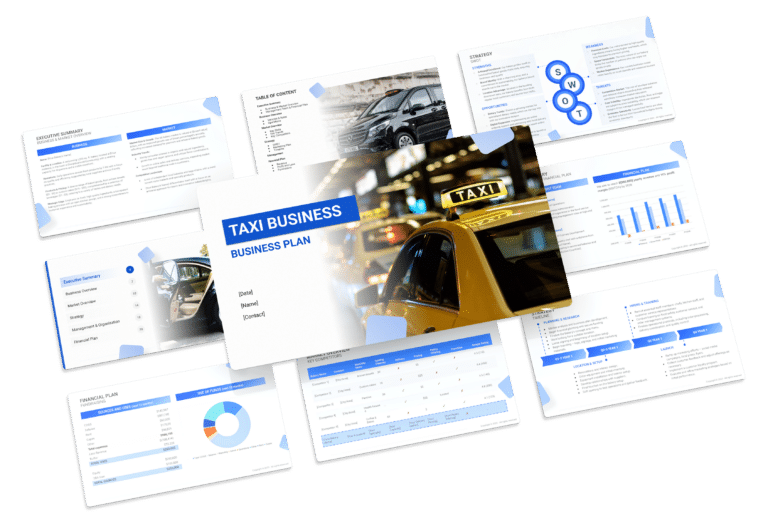How to Prepare a SWOT for a Trucking Business

Creating a business plan for a trucking company starts with a SWOT analysis. This looks at the company’s Strengths, Weaknesses, Opportunities, and Threats. The analysis considers both things the company can control (strengths and weaknesses) and external factors (opportunities and threats).
In the business plan, the SWOT analysis helps identify areas for growth and potential risks. Strengths might be having a modern fleet and skilled drivers, while weaknesses could be things like fuel costs or complex regulations.
This article will cover various strengths and weaknesses to help trucking company owners make smarter business decisions. Let’s dive in!

Strengths
Trucking Services encompass inherent strengths that make them indispensable in the logistics and transportation sector.
- Extensive Freight Capacity: Trucking companies possess a significant freight capacity, allowing for the efficient transportation of goods in varying quantities.
- Example: Investing in a diverse fleet of trucks, from small vans to large trailers, accommodates the diverse needs of clients.
- Flexibility in Delivery Routes: The flexibility to navigate diverse delivery routes enables trucking services to reach both urban centers and remote locations.
- Example: Offering express and standard delivery options allows companies to cater to time-sensitive deliveries and cost-conscious clients.
- Economic Contribution: Trucking plays a vital role in the economy by ensuring the timely delivery of goods, contributing to supply chain efficiency.
- Example: Collaborating with local businesses and industry partners fosters economic symbiosis, creating a mutually beneficial network.
- Industry Expertise: Established trucking companies often bring years of industry expertise, understanding regulations, and possessing the know-how to optimize logistics.
- Example: Conducting regular training programs for drivers on updated regulations ensures compliance and enhances the overall professionalism of the company.
Weaknesses
Recognizing weaknesses is essential for trucking companies to address operational challenges and enhance service delivery.
- Dependency on Fuel Prices: The reliance on fuel is a vulnerability, as fluctuations in fuel prices directly impact operational costs and profit margins.
- Example: Implementing fuel-efficient driving practices and exploring alternative energy sources can mitigate the impact of volatile fuel prices.
- Maintenance Costs and Downtime: Truck maintenance costs and unexpected downtime can disrupt schedules, leading to delayed deliveries and potential client dissatisfaction.
- Example: Regular, proactive maintenance schedules and investing in a well-maintained fleet reduce the risk of breakdowns and minimize downtime.
- Driver Shortages and Turnover: The trucking industry often faces challenges related to driver shortages and high turnover rates, impacting operational continuity.
- Example: Offering competitive salary packages, employee benefits, and investing in driver training programs can enhance driver retention.
- Regulatory Compliance Challenges: Adhering to complex and evolving regulatory standards poses challenges, as non-compliance can result in penalties and operational disruptions.
- Example: Establishing a dedicated compliance team and utilizing technology for real-time tracking of regulatory changes ensures proactive adherence.
Opportunities
Identifying and capitalizing on opportunities is crucial for growth and sustained success in the trucking services industry.
- Technology Integration for Efficiency: Embracing technological advancements, such as GPS tracking, route optimization, and real-time monitoring, enhances operational efficiency.
- Example: Implementing a state-of-the-art fleet management system increases visibility, reduces transit times, and improves overall service quality.
- Eco-Friendly Initiatives: Adopting eco-friendly practices, such as investing in low-emission vehicles or sustainable logistics, aligns with the growing demand for environmentally conscious solutions.
- Example: Marketing the company’s commitment to sustainability and offering carbon-neutral transportation options can attract environmentally conscious clients.
- Expansion of Specialized Services: Diversifying services to include specialized offerings, such as temperature-controlled transport or hazardous material handling, taps into niche markets.
- Example: Developing targeted marketing campaigns highlighting expertise in specialized services attracts clients with unique transportation requirements.
- Collaboration with E-commerce Platforms: Partnering with e-commerce platforms for last-mile delivery services capitalizes on the booming online retail sector.
- Example: Offering seamless integration with e-commerce systems, providing real-time tracking, and ensuring timely last-mile delivery enhances the company’s appeal to online retailers.
Threats
Anticipating and mitigating threats is crucial for the sustained success of trucking services in a competitive and ever-evolving market.
- Economic Downturns and Recession: Economic uncertainties and recessions may lead to reduced shipping demands, impacting the volume of business.
- Example: Implementing flexible pricing structures and diversifying services to include storage or warehousing during downturns can stabilize revenue streams.
- Emergence of Autonomous Vehicles: The potential rise of autonomous vehicles poses a threat, as it may disrupt traditional trucking operations and impact the need for human drivers.
- Example: Investing in research and development to explore autonomous driving technologies or adapting existing operations to complement autonomous systems ensures future readiness.
- Global Trade and Tariffs: Changes in global trade policies and tariffs can affect the flow of goods, leading to shifts in transportation routes and potentially reducing business opportunities.
- Example: Proactively monitoring trade policies, diversifying international routes, and offering consultation services on navigating trade complexities can mitigate risks.
- Natural Disasters and Supply Chain Disruptions: Natural disasters and unforeseen disruptions in the supply chain can halt transportation operations and create challenges for timely deliveries.
- Example: Establishing contingency plans, collaborating with risk management agencies, and offering insurance packages that cover supply chain disruptions provide clients with reassurance.





